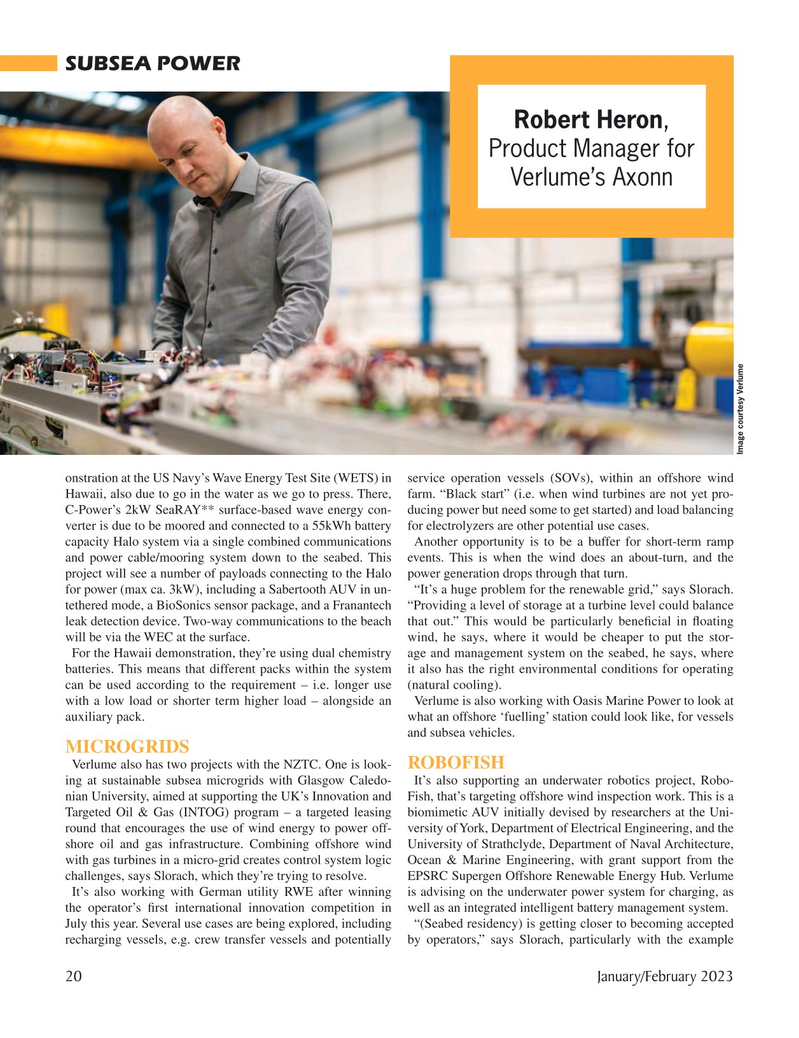
Page 20: of Marine Technology Magazine (January 2023)
Read this page in Pdf, Flash or Html5 edition of January 2023 Marine Technology Magazine
SUBSEA POWER
Robert Heron,
Product Manager for
Verlume’s Axonn
Image courtesy Verlume onstration at the US Navy’s Wave Energy Test Site (WETS) in service operation vessels (SOVs), within an offshore wind
Hawaii, also due to go in the water as we go to press. There, farm. “Black start” (i.e. when wind turbines are not yet pro-
C-Power’s 2kW SeaRAY** surface-based wave energy con- ducing power but need some to get started) and load balancing verter is due to be moored and connected to a 55kWh battery for electrolyzers are other potential use cases. capacity Halo system via a single combined communications Another opportunity is to be a buffer for short-term ramp and power cable/mooring system down to the seabed. This events. This is when the wind does an about-turn, and the project will see a number of payloads connecting to the Halo power generation drops through that turn. for power (max ca. 3kW), including a Sabertooth AUV in un- “It’s a huge problem for the renewable grid,” says Slorach. tethered mode, a BioSonics sensor package, and a Franantech “Providing a level of storage at a turbine level could balance leak detection device. Two-way communications to the beach that out.” This would be particularly bene? cial in ? oating will be via the WEC at the surface. wind, he says, where it would be cheaper to put the stor-
For the Hawaii demonstration, they’re using dual chemistry age and management system on the seabed, he says, where batteries. This means that different packs within the system it also has the right environmental conditions for operating can be used according to the requirement – i.e. longer use (natural cooling). with a low load or shorter term higher load – alongside an Verlume is also working with Oasis Marine Power to look at auxiliary pack. what an offshore ‘fuelling’ station could look like, for vessels and subsea vehicles.
MICROGRIDS
Verlume also has two projects with the NZTC. One is look- ROBOFISH ing at sustainable subsea microgrids with Glasgow Caledo- It’s also supporting an underwater robotics project, Robo- nian University, aimed at supporting the UK’s Innovation and Fish, that’s targeting offshore wind inspection work. This is a
Targeted Oil & Gas (INTOG) program – a targeted leasing biomimetic AUV initially devised by researchers at the Uni- round that encourages the use of wind energy to power off- versity of York, Department of Electrical Engineering, and the shore oil and gas infrastructure. Combining offshore wind University of Strathclyde, Department of Naval Architecture, with gas turbines in a micro-grid creates control system logic Ocean & Marine Engineering, with grant support from the challenges, says Slorach, which they’re trying to resolve. EPSRC Supergen Offshore Renewable Energy Hub. Verlume
It’s also working with German utility RWE after winning is advising on the underwater power system for charging, as the operator’s ? rst international innovation competition in well as an integrated intelligent battery management system.
July this year. Several use cases are being explored, including “(Seabed residency) is getting closer to becoming accepted recharging vessels, e.g. crew transfer vessels and potentially by operators,” says Slorach, particularly with the example 20 January/February 2023
MTR #1 (18-33).indd 20 1/22/2023 8:01:32 PM

 19
19

 21
21
